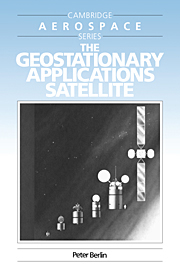Book contents
- Frontmatter
- Contents
- Dedication
- Preface
- List of Acronyms
- 1 Launch vehicles
- 2 The transfer orbit
- 3 The geostationary orbit
- 4 The satellite environment
- 5 Structures
- 6 Mechanisms
- 7 Thermal control
- 8 Power supply and conditioning
- 9 Propulsion and orbit control
- 10 Attitude stabilization, measurement and control
- 11 Telemetry, tracking and command (TT&C)
- 12 Communications payload
- 13 Meteorological payload
- 14 Product assurance
- 15 Spacecraft development and testing
- Index
11 - Telemetry, tracking and command (TT&C)
Published online by Cambridge University Press: 02 February 2010
- Frontmatter
- Contents
- Dedication
- Preface
- List of Acronyms
- 1 Launch vehicles
- 2 The transfer orbit
- 3 The geostationary orbit
- 4 The satellite environment
- 5 Structures
- 6 Mechanisms
- 7 Thermal control
- 8 Power supply and conditioning
- 9 Propulsion and orbit control
- 10 Attitude stabilization, measurement and control
- 11 Telemetry, tracking and command (TT&C)
- 12 Communications payload
- 13 Meteorological payload
- 14 Product assurance
- 15 Spacecraft development and testing
- Index
Summary
Introduction
Spacecraft controllers on the ground rely on telemetry to monitor the configuration and the health of a satellite. Telecommands provide the means to reconfigure, reorient and reposition the satellite by remote control. Tracking is a method of obtaining an update of the satellite's orbital elements.
The permanent loss of TT&C capability is the beginning of the end for a satellite. It will perhaps provide adequate service for hours, days or even weeks, but eventually it will drift away from its orbital location and nominal attitude. In the end it may degrade gracefully or suffer instant catastrophic failure as batteries discharge, propellants freeze, or electrical faults proliferate in the absence of corrective action from ground controllers.
Temporary loss of telemetry, telecommand and tracking is quite commonplace. Fortunately, the loss (called an “outage”) is seldom the result of a satellite anomaly, but is usually triggered by a failure of the control centre computer, the ground station equipment or the data link connecting the two. Even so, spacecraft controllers are invariably seized by a feeling of impending doom when outages occur, and they act swiftly to restore contact before the satellite has come to harm.
Subsystem Architecture
Figure 11.1 shows the layout of a typical TT&C subsystem. Telecommands from the ground are picked up by a receiver. After demodulation they are passed on to a telecommand decoder. The decoder verifies the validity of commands, interprets their contents, and issues execution signals to the appropriate subsystem.
- Type
- Chapter
- Information
- The Geostationary Applications Satellite , pp. 149 - 159Publisher: Cambridge University PressPrint publication year: 1988

